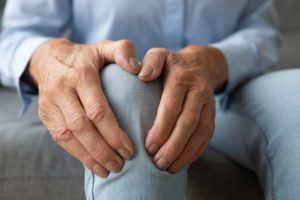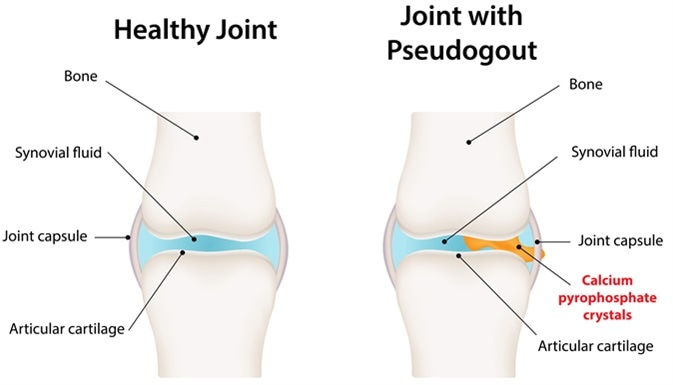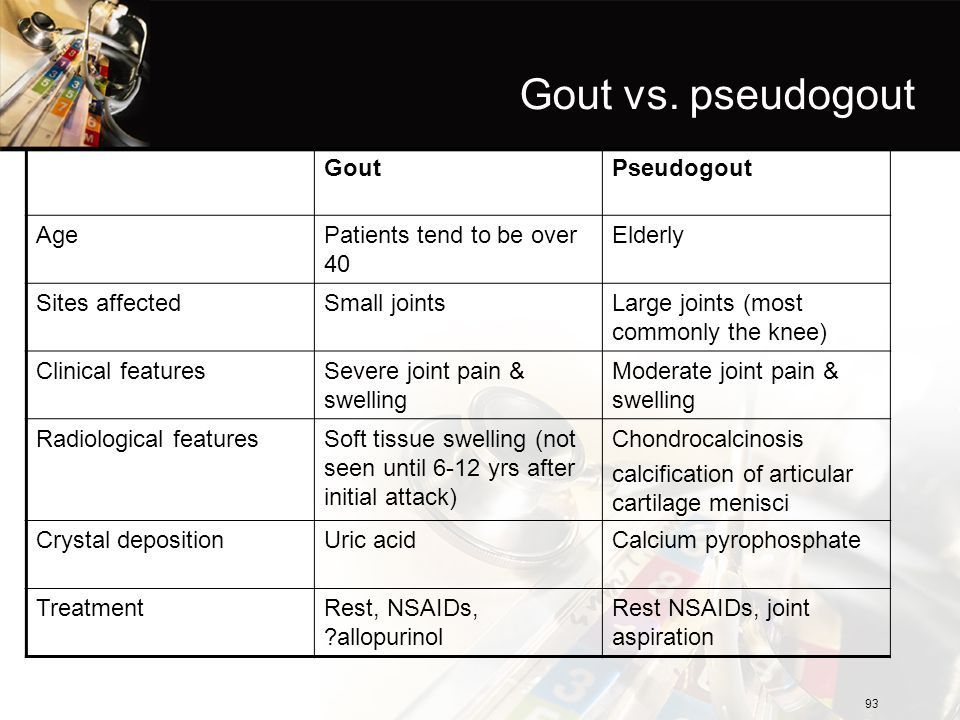 Gout is an inflammatory type of arthritis that’s caused by crystal deposits that build up in the joint. It can be confused for another condition that involves crystal build-up. Both gout and pseudogout cause sudden pain, swelling, and redness, making the two diseases challenging to tell apart. Finding the difference helps with treating and preventing flare-ups. Learn how to recognize the difference between gout and pseudogout.
Gout is an inflammatory type of arthritis that’s caused by crystal deposits that build up in the joint. It can be confused for another condition that involves crystal build-up. Both gout and pseudogout cause sudden pain, swelling, and redness, making the two diseases challenging to tell apart. Finding the difference helps with treating and preventing flare-ups. Learn how to recognize the difference between gout and pseudogout.

Joints Affected
Half of all gout attacks affect the joint in the big toe. Gout attacks typically affect only one joint and pseudogout attacks typically affect between 1 and 4 joints. In addition, the locations of the flare-ups differ.
- Gout – It is often found in the big toe. Along with the big toe, joints that are commonly affected are the lesser toe joints, the ankle, the heel, and the knee. Women are less likely than men to get gout. About 50% of men will get gout the first time it will be in the big toe and for women, an attack is most likely to involve a knee.
- Pseudogout – Pseudogout commonly affects the knee or wrist. Less often, it can involve the hips, shoulders, elbows, finger joints, toes, or ankles. Unlike gout, it rarely affects the big toe.
Causes
Both gout and pseudogout are caused by microscopic crystals that collect in a joint and trigger inflammation, which causes pain.
- Grout crystals are uric acid crystals
- Pseudogout crystals are calcium pyrophosphate crystals. Not everyone that has calcium crystal in a joint will have inflammation and pain. It is not understood why these crystals lead to painful flare-ups in only some people and not others.
Severity, Timing, and Duration of Pain
An attack of gout can occur suddenly, often waking you up in the middle of the night with the sensation that your big toe is on fire. The affected joint is hot, swollen and so tender that even the weight of the sheet on it may seem intolerable.
- Gout pain tends to be more severe and usually sticks in the middle of the night. Gout symptoms will usually go away within a few day or weeks
- Pseudogout pain may flare up at any time of day. Pseudogout episodes can last days, weeks, or even months.
The flare-ups may go away on their own but treatment is encouraged. Both can damage joints without treatment.
Tendon Involvement
The build-up of calcium deposits in Pseudoout and the build-up of uric acid crystals in gout are called calcifications. Tendon calcification can occur. With pseudogout, calcifications can be seen on x-rays as thin lines that run in the same direction as the tendon. This will cause tendons to be inflamed and painful. With gout the calcification can be detected by musculoskeletal ultrasound. Both gout and pseudogout are treatable conditions. If you suspect you have either it is advised to seek a definitive diagnosis for treatment so your joints are not damaged.
For persistent pain that is interfering with your daily activities, see a rheumatologist to make the correct diagnosis and begin the proper treatment.
Contact Us (859-331-3100) For More Information to Request an Appointment

—
 About Tristate Arthritis and Rheumatology
About Tristate Arthritis and Rheumatology
Tristate Arthritis and Rheumatology is first and largest Rheumatology practice in the Northern Kentucky area. Founded by Dr. Arthur Kunath in 1986, our rheumatology practice now consists of six doctors who are board certified in both Internal Medicine and Rheumatology and a Physician Assistant. Patients see one doctor (except in emergencies), thereby assuring continuity of care and an individualized doctor-patient atmosphere giving the physician the ability to establish personalized and detailed relationships. Our doctors have received numerous awards, including being listed as “Top Doctors” in Cincinnati Magazine, receiving the Patient’s Choice Award, the Most Compassionate Doctor Award, and the American College of Rheumatology’s “My Doc Rocks” award.
>> Learn More


